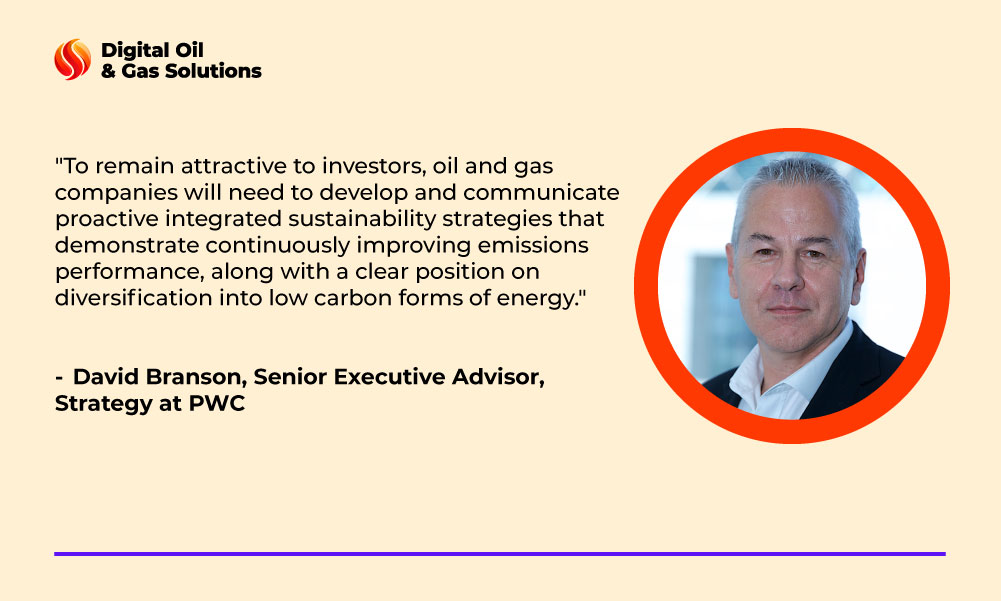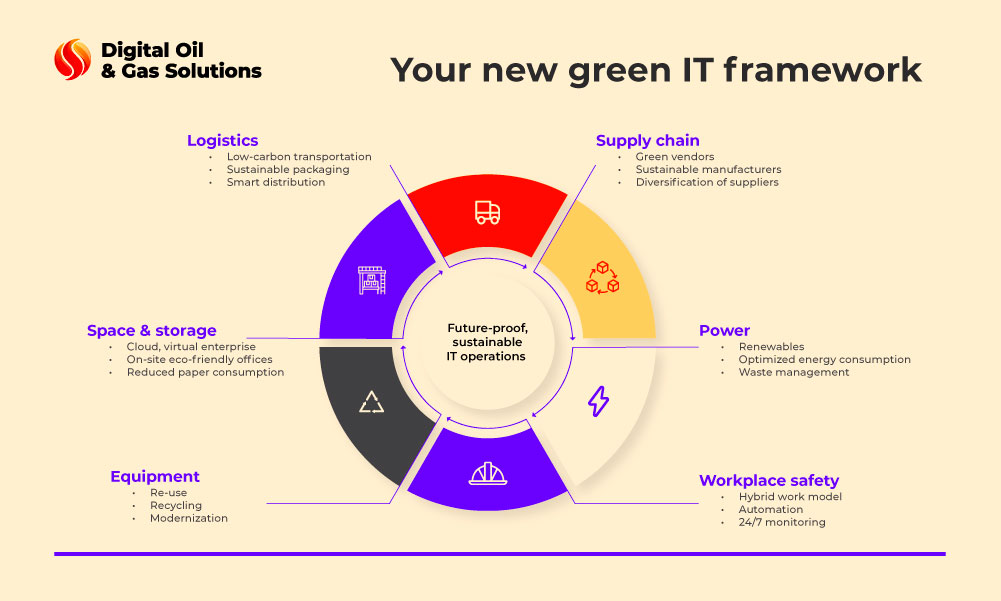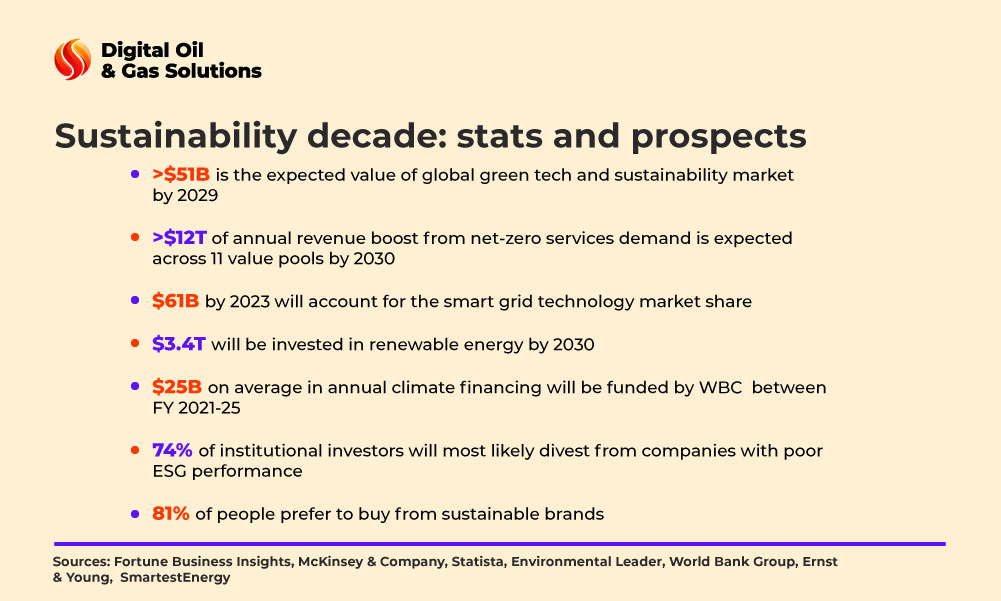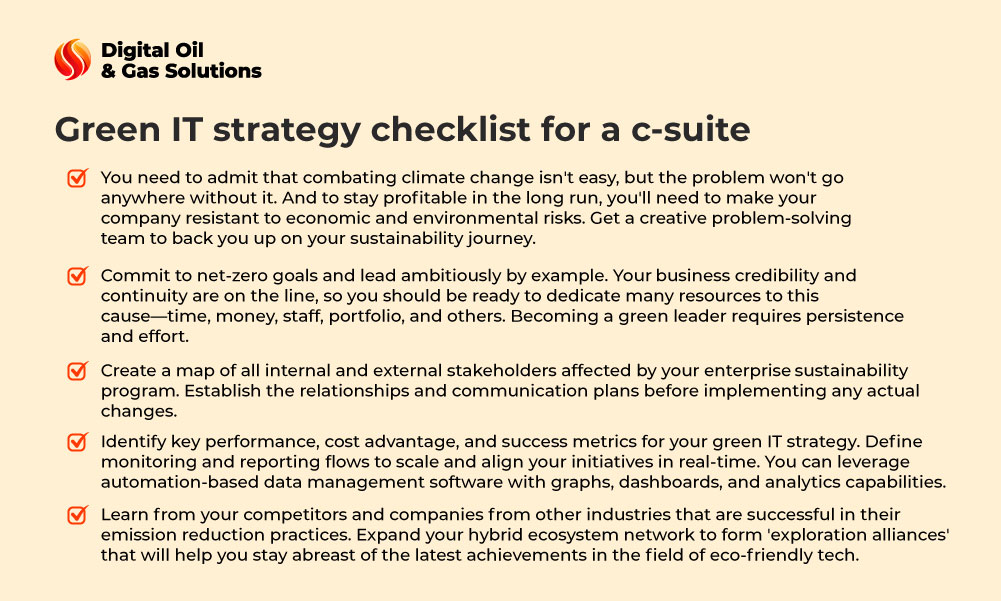The 2050 net-zero goals and current crises have increased the demand not only for low- and zero-carbon materials but also for green IT. But what is it, and what is the greatest benefit of green information technology? Today we answer these questions for you. Discover how to make green information technology effectiveness your competitive edge and guarantee business sustainability.
The 3 W’s of green computing: what, why, where
Digitalization is no longer a trend but a must for companies that want to ensure greener production and stay competitive. Embracing digital workflows is the first step in decarbonizing O&G operations and value chains. But what about stats that say the ICT sector itself is a carbon footprint source? We say renewable energy sources and green information technology solve this dilemma.
1. What’s green IT?
Green information technology is a global movement of engineers using a set of more ecological design-and-development methodologies, tools, and practices. In other words, it’s a facilitation of environmentally responsible computing and telecommunication to minimize the negative impact of all IT initiatives.

2. Why should you care about greening your IT?
Industry 4.0 continues and Gartner expects global IT investment to grow by 3% in comparison with 2021 and hit $4.5 trillion in 2022. Consequently, the ICT sector will keep snowballing. It can lead to enormous energy consumption, hazardous events, and uncontrollable electronic waste. That’s why a collective effort of the ICT and O&G industries is crucial for combating global warming and improving work environment safety.
Both sectors are already fully committed to reducing environmental impact, and the mobile net-zero trajectory is also on track. What does this mean for your company’s agenda? You might want to put sustainability at the center of your updated business value proposition. Turn ESG eligibility and green information technology adoption into a strategic commitment for your organization.

3. Where should you look for advantages?
Green information technology is the fastest way to elaborate a beneficial net-zero strategy without compromising your business continuity. You can leverage eco-friendly computing to strengthen your corporate sustainability and analyze emissions level before modernizing any physical assets. Besides, going green can save many resources and materials across a wide range of IT operations.
5 tips to quickly turn your company’s IT department into a green one
Achieving green information technology effectiveness calls for the c-suite to be agile and get out of their comfort zone. You’ll be collecting and analyzing vast amounts of unique sustainability-related data. So, the results will require dynamic organizational changes and prompt reaction to re-align your IT and business processes on the go. To minimize your technological footprint without extra stress, Digital Oil & Gas Solutions experts share the following recommendations.
1. Optimize your energy consumption
Conduct regular energy audits to analyze daily and monthly energy consumption levels of your IT department. Work on power-use optimization for all digital equipment to prevent waste. Centralize network resources by monitoring energy efficiency and environmental health 24/7.
Actions you should take:
- Map out energy flows across your IT department to track and benchmark performance stats.
- Use devices labeled with the “Energy Star” and replace outdated equipment with the newest models that require less energy by default.
- When you and your staff aren’t using digital devices, put them in sleep mode, or even unplug and shut them down.
- Monitor your air conditioning systems in IT-related office spaces to avoid excessive energy consumption. Keep them turned off as often as possible.
- Try to repair and re-use IT equipment whenever possible. In case of a total loss, follow eco-friendly disposal practices to recycle it.
2. Design a green information technology strategy
Assign a sustainability team to assess the carbon footprint of your existing IT processes and prioritize key green metrics and data sources. This team should calculate all critical GHG emissions, following with propositions to reduce them throughout the year ahead.
Together, create an actionable plan that will cover all resources, tools, SMART goals, and budgets you’ll need. Develop IT operating models that will support your enterprise-wide sustainability management framework. When a strategy is ready, share it with your stakeholders to get their support. Share the progress of sustainability initiatives with them regularly
3. Get yourself an “in-cloud apartment”
Owning on-premise server rooms is no longer cost-effective nor sustainable when you can have it all in the cloud. So, we recommend migrating your IT workloads to virtual machines, ensuring solid security and saving on facilities, hardware, materials, and air conditioning.
Cloud technologies are not only greener. They accelerate your time to market, enhance IT system availability, shorten the deployment cycle by automating manual routines, which drives ROI. But we advise selecting a conscious cloud vendor that provides smart resource management tools, hibernation options, and other best practices for energy efficiency.
4. Create digital oil fields
Make the most of industrial IoT sensors, digital twin technology, cognitive automation, and real-time data collection to improve decision-making, productivity, and risk management. A virtual copy of your production empowers you to use advanced data analytics, see where the biggest emissions come from, and prevent catastrophic events in all departments.
Field digitalization facilitates and promotes remote work, keeping your workforce safe and boosting your green information technology’s positive environmental impact. Finally, AI and ML technologies can provide you with actionable insights into inventory needs and supply chain disruptions, unleash new types of O&G resources, and more.
5. Use smart grids to power your IT with renewable energy
Smart alternative grids backed by intelligent digital devices mitigate your dependence on non-renewable sources and reduce energy waste. Moreover, you can monitor consumption levels for continuous improvements within the IT infrastructure. So, renewables are beneficial in the long run as an effective environmental protection instrument. You can either set up your own grids and backup batteries or procure alternative electricity from established suppliers.

What is the greatest benefit of green information technology, though?
Of course, green information technology’s contribution to the environment and humanity is immeasurable. But answering the question of how your business can capitalize on socially responsible computing, the main point will be meeting the expectations of eco-conscious and sophisticated investors and customers. Today many of them favor and prioritize eco-friendly companies that are transparent about their carbon footprint. So yes, the adoption of green information technology pays off. But that’s not all and there are other benefits that your O&G company can expect from green IT, since it:
- Unlocks new value streams and niche markets
- Streamlines production and IT processes
- Eliminates operational inefficiencies
- Frees physical space and resources
- Reduces equipment maintenance costs
- Improves business performance and productivity
- Boosts brand value and awareness

O&G and sustainable IT—a strategic alliance for a greener future
It’s obvious that a broad adoption of green information technology will be vital for the success of global energy transition initiatives. As of now, even despite the current economic headwinds, sustainability commitments result in increased shareholder value. But the journey of getting your IT to a green point is challenging. So, we advise developing a mature transformation strategy that reflects your company’s specifics and relies on its strengths.







